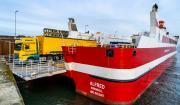
This site uses cookies, by continuing to use this site you accept the terms of our privacy policy
Feed 2.0 Loading...
Two vessels make their debut visits to Gills Harbour
10th May 2015
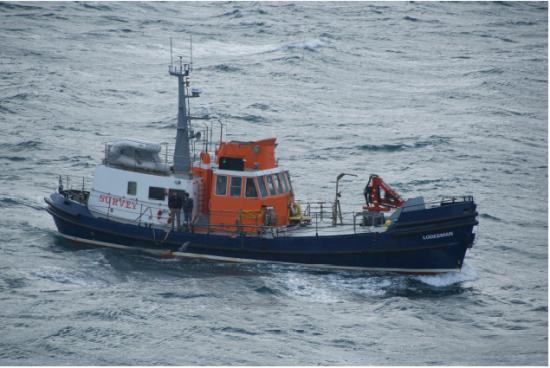
Two vessels made their debut visits to Gills Harbour on the morning of Sunday, May 10th, 2015.
The mini-ships Uskmoor and Lodesman sailed across the Pentland Firth from Orkney to conduct operations in the Inner Sound of the narrow, tide-swept, channel separating Caithness from the isles.
Just 36 hours earlier, an official 'Notice to Mariners' was issued by Glasgow-based survey company Partrac Ltd.
It provided precise positions in the Inner Sound from where the company would be conducting its marine operations, without naming the vessels to be utilised.
The steel-hulled, 16 metre-long, Uskmoor is owned and operated by Leask Marine of Kirkwall. She has a 4-tonne-capacity gantry crane at her stern, serviced by a single-barrel hydraulic winch, while a powerful Hiab crane fitted on one side can lift up to 3.8 tonnes at maximum alignment.
Leask Marine, headed by its award-winning entrepreneur Mr Douglas Leask, its managing director, operates seven vessels. This is the biggest fleet servicing the nascent marine renewables industry in the Pentland Firth & Orkney waters.
Its 25 metre-long many purpose rectangular-shaped 'multi-cats' C-Salvor and C-Odyssey have been fairly regular users of Gills Harbour over the past 18 months, as work on Atlantis Resources plc/MeyGen Ltd's pioneering £50 million 'Demonstration Array' of four electricity-generating tidal turbines has gathered pace. C-Salvor has recently been contracted to James Fisher Marine Services (JFMS), which holds the Inner Sound marine contract from the above.
Uskmoor has been used extensively in launching and recovering sophisticated Acoustic Doppler Current Profilers (ADCPs) at the tidal test-site of the European Marine Energy Centre (EMEC) at Falls of Warness, off Eday island in Orkney. She arrived at Gills Harbour just before 7:00 am on 10.05.14.
She has also been used 'in supporting inshore cable-laying projects throughout the UK', the company states. It is understood that several vessels in the Leask Marine fleet have charter-work overseas at present; the company added a third tug-style multi-cat, C-Chariot, to its successful fleet earlier this Spring (2015).
The 22 metre-long (72') Lodesman, which sailed in from Stromness, arrived at the 'Canisbay peoples port' shortly after 9:00 am on 10.05.15 .
She is a former Trinity House pilot vessel with a steel hull and a superstructure made of lighter 'glass reinforced plastic' (grp).
Lodesman is described as the 'primary work boat' of Roving Eye Enterprises, of Orphir, Orkney, on the shores of Scapa Flow.
Her owners state that, having been built as a '24-hour, all-weather pilot-boat' that their 'very capable manoeuvrable vessel is able to work in the extreme environment of the Pentland Firth in safety and comfort'.
This 80-tonne 'mini-ship has been specially modified to make Lodesman even more suitable for sea-operations using ROVs (remote-operated vehicles) which are tethered to and controlled from the mother-ship Lodesman for a wide range of underwater tasks for the 'marine electricity' market.
Both vessels have been used for ADCP work.
Partrac Ltd's operations this week are for recovering three six-sided stainless-steel 'cages' of 1.8 x 1.8 metres, that had been used to house ADCPs just over 0.5 metres off the seabed.
The frames are all attached to a 160 metre-long single steel wire ground-rope, while several other ground-weights are also being recovered after having spent the past winter under the 33 metre deep waters of the Inner Sound.
Those had all been used in the extensive Turbulence in the Marine Environment (TIME) study which Partrac Ltd operated for the Government-backed practical 'renewables' research body the Carbon Trust in the autumn of 2014 from Gills Harbour.
This was the most expensive applied-science experiment run in Caithness since Dounreay's heyday and was designed to find out about 'turbulence' affecting the Inner Sound's restless water-column half-way up between the seabed and it surface, roughly at the height of hubs of planned tidal turbines.
Top Carbon Trust marine scientist Dr Angus Vantoch-Wood came to Gills Harbour during the month-long test-programme of works that was not directly linked to MeyGen Ltd's activities there; it also made use of the pioneering Canadian-built Nemo buoy, which was recovered from the Sound last October.
During the past two weeks community-owned Gills Harbour Ltd has been represented at two major Scottish conference and exhibitions; The Scottish Highland Renewable Energy Conference in Inverness and the main European renewables All-Energy event that was held in Glasgow's Scottish Exhibitions & Conference Centre (SECC) for the first time, having been previously hosted in Aberdeen.
Both annual milestone events were opened by Mr Fergus Ewing MSP, the Scottish Government's Minister for Energy and Tourism, who re-iterated his intention to visit Gills Harbour for the first time in the near future.
Mr Bill Mowat, the former four-term (16 years) elected representative for NE Caithness on the Inverness-based Highland Council, is the chairman of the Canisbay harbour company.
He said: 'We are pleased to see that Gills Harbour is the little port of choice for mini-ships involved in Inner sound operations. We know that there will be much activity here over the coming months as works with the Inner Sound tidal electricity Demonstration Array roll out.
'The MeyGen Ltd sub-sea site lies between 1 and 1.5 miles off our harbour's entrance channel. The main operators and managers of small ships, such as Uskmoor and Lodesman, have been telling us about wishing to see our facilities being enhanced to make Gills Harbour even more suitable for those and multi-cats and we intend responding to this as positively as is possible for us'.
PHOTO
Lodesman
Overall design was by Burness Corlett & Partners to Lloyds
specifications. The hull is steel and superstructure G.R.P.
Certified as a Category 2 Vessel ( Up to 60 miles from a safe
haven)
General Information
Length: 21.67M
Beam: 5.48M
Draught 2.6M
Gross Tonnage 80
Service Speed 9knts
Main Equipment
Main Engines 2 x Gardner 8L3B's (230HP [AT] 1150RPM)
with Gardner gear boxes 2:1 reduction hydraulic operation
Steering :Tenjford hydraulic, spade rudders behind each propeller, dual
hydraulic system working from each engine as required with jockey lever
control through autopilot
Generators: 10KVA Kubota and 40KVA Perkins
Guerra Crane : 4.5M [AT] 800KG
Crew: 2-4 depending on operations
Scientific Officers: up to 12
Accommodation : 3 x cabins, Survey room and galley/mess
Large deck space forward of the wheelhouse.
Related Businesses
Related Articles
21/10/2022
Three Cats At Gills Harbour
Two catamaran work-boats berthed at Gills Harbour this week with the trans-Pentlnd ferry MV Alfred, also a catamaran, in the background. The larger workboat is MPC Athenia which was being used as a floating base or ROVs - remote underwater vessels, for detailed inspections on the three turbines operating at the MeyGen demonstration subsea site one and a half miles off Gills Harbour.
12/6/2022
GILLS HARBOUR Ltd ANNUAL GENERAL MEETING
GILLS HARBOUR Ltd - ANNUAL GENERAL MEETING at JOHN O'GROATS VILLAGE HALL, MONDAY JUNE 13th @ 7.30 PM. GILLS HARBOUR IS THE ONLY OFFICIALLY-RECOGNISED 'ECONOMIC DEVELOPMENT AREA' IN NE CAITHNESS.31/8/2021
Ferry Problems Getting Worse In The Scottish Fleet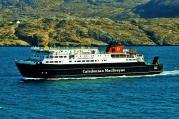
Highlands and Islands Labour MSP Rhoda Grant has again written to the Transport Minister Graeme Dey demanding Scottish Government address the urgent issues facing Scotland's Ferry Fleet. Following CalMac's announcement that it had been forced to amend timetables as the MV Hebrides was from the rotation for urgent repairs, it became clear that some communities were facing loss of their ferry service for days.
22/3/2021
Latest Boats At Gills Harbour For Work At Meygen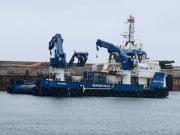
£10 million 'Isle of Jura' temporarily based at Gills Harbour in Far North of Scotland for her crew's debut tasks in the tidal-stream electricity field at the MeyGen sub-sea site, one mile off the little Caithness's port entrance channel. One of the UK's most modern marine renewables service vessels made her debut calls at community-owned Gills Harbour, near John O'Groats, over the 2021 Spring Equinoctial weekend.
23/2/2021
Busy Gills Harbour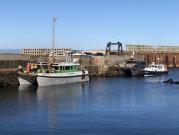
Its been a busy few days at local community-owned Gills Harbour ..... sometimes in suberb sunny weather as here ...
26/11/2020
Energy Developments Continue at Gills Harbour and the Pentland Firth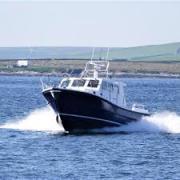
The company behind the world-leading tidal-stream prototype power plant in the Pentland Firth's Inner Sound is set to start manufacturing a new-style turbine that is hopes will reduce the project's generating costs. Simec Atlantis Energy (SAE) and a privately-owned specialist engineering firm from Spain's Bay of Biscay coastline have jointly been conducting 'research and development' (R& D) on the project for almost a year and are now ready to give it the go-ahead.
8/10/2020
New Generation of office-bearers set to step up at Gills Harbour Ltd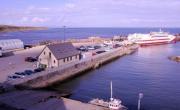
A new generation of younger local folk look set to take over the reins of running Gills Harbour Ltd, the local company that owns and operates the busy little port on the shores of the Pentland Firth's Inner Sound that holds its AGM this Saturday (10.10.20) morning at 10:00 am. The influx of younger blood comes after two key directors of the group that had run 'Canisbay's Peoples Port' both announced their retirement from office, whilst another Gills Harbour Ltd (GHL) office-bearer has declined to seek re-election.
19/8/2020
MV Alfred And MV Pentalina Together At Gills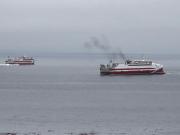
An 'old friend' returns to Gills Bay after an absence of manymonths. The 2,400 tonne 70 m.
16/8/2020
Normand Cutter, The Norwegian-owned Offshore Construction Vessel at Gills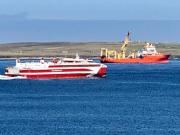
Here is the Normand Cutter, the Norwegian-owned offshore construction vessel that has been the base for works on Simec Atlantis Energy's (SAE's) MeyGen site in the Pentland Firth's Inner Sound, off Gills Bay during the current neap-tide sequence, that has lasted most of the week commencing 11.08.20. Picture by retired C of S Kirk Minister the Rev Lyall Rennie, who lives at Lower Warse, Canisbay, on the shores of Gills Bay..
9/1/2020



